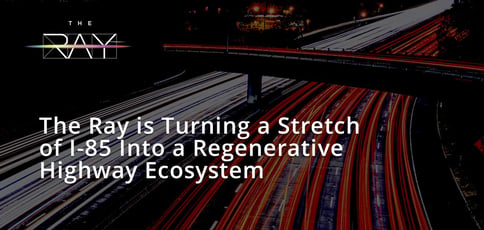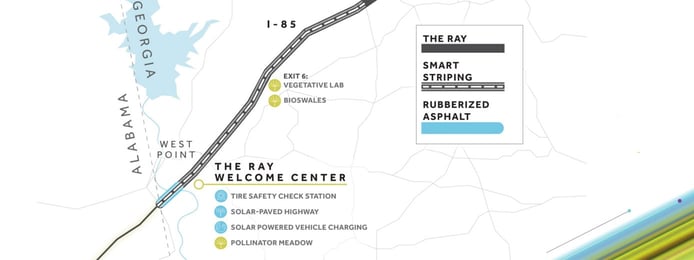
TL; DR: The Ray, a nonprofit organization and 18-mile stretch of I-85 developed through a public-private-philanthropic partnership (P4) model. The idea is to create a blueprint for sustainability across America’s highways by experimenting with revolutionary innovations and unprecedented ways of thinking. In the long term, the team behind The Ray hopes to meet the ambitious goal of zero deaths, zero carbon, and zero waste along the highway.
When Ray C. Anderson passed away in 2011, his youngest daughter, Harriet, wanted to honor his legacy as a leading voice in industrial sustainability.
She got her wish in July 2014, when the state of Georgia, where her father was born and died, agreed to rename the stretch of I-85 that extends from Exit 2 to 18 as the Ray C. Anderson Memorial Highway.
Harriet quickly snapped a few photos in celebration, but her excitement was short-lived.
“Later that night, Harriet got home, poured herself a glass of wine, looked at her husband, Phil, and said, “Did I just put daddy’s name on a dirty highway?” said Anna Cullen, Director of External Relations at The Ray. “She Googled ‘sustainable highway,’ but nothing came up, so she called Allie Kelly, who was working at the Georgia Conservancy, and they started brainstorming.”

The Ray is a sustainable stretch of highway in Georgia that serves as a model for future development.
What started with a few ideas — potentially planting wildflowers or putting up a solar panel — eventually blossomed into The Ray, an independent nonprofit. With support from the Ray C. Anderson Foundation, an organization created to honor its namesake, The Ray took on the responsibility of transforming the Ray C. Anderson Memorial Highway and its surrounding acres into a global model for green transportation.
Allie Kelly now leads the nonprofit as Executive Director. Between 2015 and 2018, the Ray C. Anderson Foundation granted approximately $4.5 million in funding to support The Ray in reimagining transportation infrastructure.
“Today, The Ray is pursuing a much larger, more holistic mission of defining what a sustainable highway is,” Anna told us.
A Proof of Concept Inspired by the Legacy of Ray C. Anderson
In many ways, The Ray serves as a living laboratory for the infrastructure of the future — and that’s something that Ray C. Anderson, often referred to as the world’s greenest CEO, would have appreciated.
“Ray C. Anderson is the grandfather of corporate sustainability — the large Fortune 500s of today would not have their corporate sustainability programs without him,” Anna said.
In 1973, Ray founded the Atlanta-based company Interface Inc., one of the first manufacturers of modular carpet squares in the U.S. By the early 1990s, investors and employees in California approached him with inquiries about his environmental stance and actions.
“He said, ‘I comply with all rules and regulations,’ but they said, ‘That’s not enough, Ray,’” Anna said. “Eventually, Paul Hawken’s book, ‘The Ecology of Commerce,’ landed on his desk — and changed his life. Ray realized, in his words, that his carpet manufacturing business, Interface, was destroying the planet for future generations, and it was his personal responsibility to do something about it.”
At that moment, Ray decided his company would be carbon neutral by the year 2020. It was a remarkable goal in the early 90s, when environmental issues weren’t yet given a significant platform in the mainstream media.
“He stood up for what he believed in and made it happen,” Anna said. “Today, his company is beyond carbon neutral. And if you can make a dirty manufacturing process carbon neutral, you can do anything.”
Creating a Repeatable Blueprint for America’s Highways
Today, The Ray serves as a pillar of sustainability in Southwest Georgia that can be used to inspire highways of the future. Anna told us that pre-coronavirus, the nonprofit would frequently hold field tours and other events.
“We were hosting almost two a week, and people were traveling from as far as Australia to come, as we say, to ride The Ray and see the different technologies that we have along our 18 miles,” she said. “We love to share ideas and learn from each other and then take back the best of both worlds.”
But the organization’s mission certainly doesn’t end there.
“If we create 18 special miles of sustainable infrastructure in Georgia, that’s great. But it doesn’t really accomplish our goals,” Anna said. “We knew we had to create a blueprint that can be scaled and replicated across Georgia and beyond.”

The Ray is a testing ground for sustainable interstate initiatives.
To do so, The Ray functions through a charter partnership with both the Georgia Department of Transportation (GDOT) and the Federal Highway Administration (FHWA).
“Georgia is not only going to help us break through some of the red tape that typically inhibits innovation, but they’re going to help us scale across the state,” Anna said. “The FHWA’s role, then, is to help us replicate what works in Georgia across the rest of the country.”
Since 50 states mean 50 different government structures, The Ray has a position dedicated solely to facilitating strategic partnerships that help municipalities and states accomplish similar goals in their local areas.
A Public-Private-Philanthropic Partnership (P4) Model
Public-private partnerships (P3s) are valued for their ability to improve services and enhance a locality’s capacity to operate effectively via a cooperative arrangement between two or more public and private sectors. The Ray takes that model and makes it even better by adding a charitable aspect.
“We call the way we work a public-private-philanthropic partnership (P4),” Anna said. “We bring in philanthropic dollars that allow states to take more risk and try new things.”
The model is particularly resilient to economic hardship — such as that caused by the recent COVID-19 pandemic. “We are attracting shovel-ready projects that we can keep going because we have those private dollars that we’re bringing in,” Anna said. “We’ve got a model that we know is working and that we can scale despite the current situation.”
Infrastructure projects, in general, are critical in reviving economies. If they can be done in a way that also contributes to a cleaner, greener environment, that’s even more valuable. To that end, The Ray has quite a few tricks up its sleeve.
“To pick just one example, we should be paving roads with rubberized asphalt,” Anna said. “We can take old tires out from the landfill and make a better, longer-lasting, quieter road. This is something that we should do right now — but as a society, we aren’t because it’s different from the way we’ve done things before. Our goal is to provide that extra push to make things like that happen.”
Advancing Solar Energy Generation Along the Highway
In terms of future plans, Anna said she’s particularly excited about the potential for solar farms on empty interstate land that is already owned by local departments of transportation. In September 2016, the Georgia Public Service Commission (GPSC) approved a pilot project for Georgia Power to install one megawatt of solar generation in the right of way alongside The Ray. Construction on the project began in early 2019. Today, drivers can see approximately 2,600 solar panels as they pass through The Ray.
“This is a way to better utilize space at a time when we are in major competition for land, whether it’s used for agriculture, cattle, or other use cases,” Anna said. “But the land that’s along the right of way of an interstate shoulder is not being used for anything.”
Today, many departments of transportation are strapped for cash, partially due to a decrease in gas tax revenue as vehicle traffic has dropped during the COVID-19 outbreak.
“Our state governments are looking to cut fundings; they need new revenue sources,” Anna said. “And revenue can come from leveraging that land to generate clean, renewable energy.”
To encourage similar action across the U.S., The Ray has partnered with the University of Texas Austin to analyze each mile of right-of-way throughout the United States for its potential as a site for solar energy generation. The results will be presented through an upcoming online tool.
In the meantime, The Ray encourages anyone with an idea that could contribute to a more sustainable highway ecosystem to share their thoughts.
“There are so many entrepreneurs out there with smart ideas, so we’ve developed a place on our website called Let’s Talk,” Anna said. “Let’s face it — we can’t be at all the right conferences, especially now. So we want to gather as many ideas as we can.”
HostingAdvice.com is a free online resource that offers valuable content and comparison services to users. To keep this resource 100% free, we receive compensation from many of the offers listed on the site. Along with key review factors, this compensation may impact how and where products appear across the site (including, for example, the order in which they appear). HostingAdvice.com does not include the entire universe of available offers. Editorial opinions expressed on the site are strictly our own and are not provided, endorsed, or approved by advertisers.
Our site is committed to publishing independent, accurate content guided by strict editorial guidelines. Before articles and reviews are published on our site, they undergo a thorough review process performed by a team of independent editors and subject-matter experts to ensure the content’s accuracy, timeliness, and impartiality. Our editorial team is separate and independent of our site’s advertisers, and the opinions they express on our site are their own. To read more about our team members and their editorial backgrounds, please visit our site’s About page.

